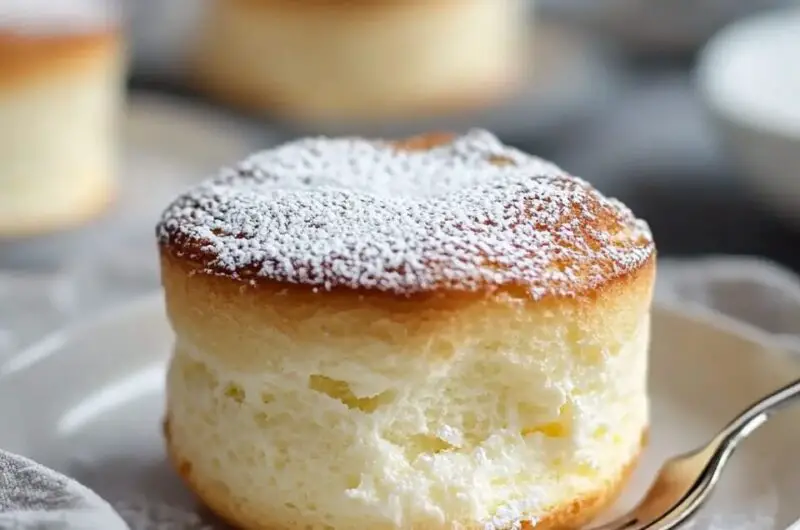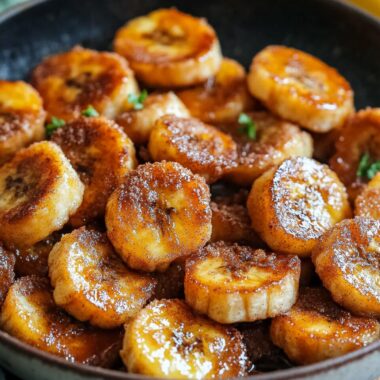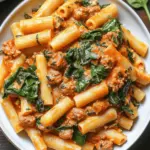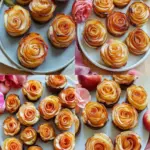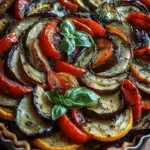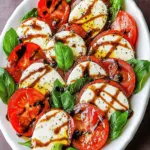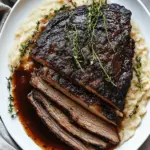The Classic French Vanilla Soufflé is the epitome of elegant simplicity, a showstopping dessert that relies on careful technique to transform humble ingredients into an ethereal, cloud-like masterpiece. With a base of vanilla-infused pastry cream and light-as-air whipped egg whites, this soufflé rises dramatically in the oven, delivering a warm, delicately sweet flavor with a melt-in-your-mouth texture. From preparing the ramekins with upward butter strokes to perfecting the meringue, this recipe honors traditional French methods while offering practical tips to help any home baker achieve success. Best served immediately with a dusting of powdered sugar, it’s a sophisticated way to elevate your dessert game.
Full Recipe:
Ingredients
Base:
4 large eggs, separated
1¼ cups (300ml) whole milk
5 tablespoons (50g) all-purpose flour
6 tablespoons (90g) granulated sugar, divided
2 teaspoons (10g) pure vanilla extract
¼ teaspoon (1g) salt
For Ramekins:
Softened butter, for greasing
Granulated sugar, for coating
Topping:
Powdered sugar, for dusting
Directions
Preheat the oven to 375°F (190°C) with a baking sheet on the middle rack.
Brush 4 (8-oz) ramekins with softened butter using upward strokes. Coat with granulated sugar, then discard excess.
Warm the milk until small bubbles appear. In a bowl, whisk egg yolks with 3 tablespoons sugar until pale, then whisk in the flour. Temper this mixture with the hot milk, then return to the heat and cook until thickened. Stir in vanilla and let slightly cool.
Beat egg whites with salt until foamy. Gradually add the remaining sugar and whip to stiff peaks.
Gently fold the whipped whites into the cooled yolk mixture in three additions, folding just until combined.
Divide the batter among prepared ramekins. Place them on the preheated baking sheet and bake for 25–30 minutes until puffed and golden.
Dust with powdered sugar and serve immediately while the soufflés are still risen.
Nutrients (Per serving – approx. 4 servings)
Calories: 239
Total Fat: 6.1g
Carbohydrates: 36.5g
Protein: 9.4g
What Makes a Soufflé Special?
Unlike cakes or custards that develop a firm structure as they cool, a soufflé is defined by its temporality. The name comes from the French verb souffler, meaning “to blow” or “to puff”—and that’s exactly what happens. Egg whites whipped to stiff peaks trap air and expand in the heat, causing the soufflé to rise high above the rim of its ramekin. The moment it’s removed from the oven, the soufflé begins to collapse gently, a reminder of its delicate nature and the magic of culinary alchemy.
This vanilla version offers a clean, sophisticated flavor profile. It’s neither too sweet nor too rich. Instead, the soufflé leans into the silky comfort of pastry cream and the aromatic warmth of vanilla. It’s elegant without pretense—making it ideal for date nights, dinner parties, or quiet indulgence.
The Technique: Tradition and Precision
Success with soufflé starts with attention to detail. The ramekins must be prepped with care—softened butter brushed in upward strokes encourages a straight, tall rise, while a dusting of sugar gives the batter traction as it climbs. This is not the time for shortcuts. Skipping these steps can lead to uneven puffing or sticking.
The base of the soufflé is essentially a thickened vanilla pastry cream, created by tempering hot milk into an egg yolk and flour mixture and then cooking until it thickens to a smooth custard. This stage is crucial—it forms the stable, flavorful foundation of the dish.
Equally important is the meringue. Beating the egg whites with salt adds structure, while the gradual addition of sugar stabilizes them and allows them to reach the glossy stiff peaks needed to lift the batter. Folding the whites into the yolk mixture must be done with a gentle touch—preserving the air while ensuring the mixture is uniform. Over-mixing deflates the batter; under-mixing leaves streaks.
Finally, the soufflés must be baked on a preheated baking sheet to provide even bottom heat and then served immediately. There’s no holding time here—presentation and timing are everything.
Flavor Profile: Subtle, Warm, and Aromatic
This soufflé delivers flavor in an understated, refined way. The sweetness is balanced, with vanilla taking center stage. When made with high-quality pure vanilla extract or even vanilla bean paste, the dessert offers floral, woody, and creamy notes that echo in each bite.
Its texture is part of the experience—the spoon breaking through the lightly crisp crust reveals a warm, steamy center that’s impossibly soft and smooth. It tastes like a floating custard—delicate, not heavy; sweet, but not cloying. The dusting of powdered sugar adds a whisper of extra sweetness and visual appeal.
Serving and Pairing Ideas
Traditionally, vanilla soufflés are served on their own, fresh from the oven, with a quick dusting of powdered sugar. But they can be elevated even further with thoughtful garnishes and pairings.
A spoonful of crème anglaise poured into the center of the soufflé right before serving adds creaminess and flavor depth. A fruit coulis, especially made from berries or passionfruit, offers a tart contrast that cuts through the sweetness. For a more decadent finish, a dollop of softly whipped cream or a light scoop of vanilla bean ice cream can be served on the side.
As a beverage pairing, try a glass of chilled Sauternes, a fruity Moscato, or a cup of rich espresso for contrast.
Health and Nutritional Highlights
Despite its luxurious taste and texture, a classic vanilla soufflé is lighter than many traditional desserts. With no heavy cream or butter in the final product, it relies on eggs and milk for richness and body. Each serving provides a moderate amount of protein, primarily from the eggs, and it’s relatively low in fat compared to custards or cheesecakes.
Using whole milk adds a satisfying creaminess without the heaviness of cream, and the sugar content is kept in check. If you’re looking for an elegant dessert that feels indulgent but is on the lighter side, this soufflé fits the bill perfectly.
Troubleshooting and Tips for Success
-
Room Temperature Eggs: They whip better and integrate more smoothly into the batter.
-
Use Fresh Eggs: Fresher whites create stronger meringue.
-
Don’t Open the Oven Door: Resist the urge to peek—sudden temperature changes can cause the soufflé to collapse.
-
Serve Immediately: Soufflés wait for no one. Have your serving dishes, garnishes, and guests ready before they come out of the oven.
-
Practice Makes Perfect: Even experienced chefs have soufflés that don’t rise as planned. Don’t be discouraged—mastery comes with repetition.
Why You’ll Love This Recipe
The Classic French Vanilla Soufflé is more than just a dessert—it’s a statement. It says you took time to master a delicate process, that you value flavor as much as presentation, and that you’re not afraid to bring a little French finesse to your home kitchen. Whether you’re cooking for one or impressing a dinner party, it will always feel like a special occasion.
It’s also a flexible recipe. Once you master the vanilla base, you can experiment with other flavors: lemon, coffee, chocolate, orange liqueur, or even herbs like lavender. The base structure stays the same, offering a canvas for your creativity.
Conclusion
The Classic French Vanilla Soufflé is a timeless masterpiece in the world of desserts. It rewards precision and patience with a final product that’s ethereal, elegant, and deeply satisfying. From its dramatic rise to its creamy interior, every spoonful is a celebration of what happens when humble ingredients are treated with care and respect.
If you’ve never made a soufflé before, this is the perfect place to start. And if you’ve made many, this vanilla version will remind you why it remains a classic. Light yet luxurious, sophisticated yet simple, the soufflé is a culinary triumph—and now it can be yours, straight from your own oven.

